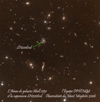

| Field of view (OMM) | 34'x34' |
| Pixel scale (OMM) | 0.5"/pixel |
| Detector | 2 x E2V42-80 2048 x 4096 pixels |
| Minimum integration time | 0.1 s |
| Readout time | 75 s |
| Overhead per dither (<30") | ~5-10 s |
| Overhead for slews of more than a few arcminutes | ~30-45 s |
| Median Full Width at Half-Maximum (FWHM) at the OMM | 2.0" |
| Readout noise | ~5 electrons |
| Linearity imit | ~30 000 ADU |
| Gain | ~3.6 e-/ADU |
| Dark current | ~0.02 e-/pix/sec at -100°C |
Filter |
λ (Å) |
Δλ (Å) |
u |
3543 |
567 |
g |
4770 |
1387 |
r |
6231 |
1373 |
i |
7625 |
1526 |
U |
3640 |
600 |
B |
4370 |
900 |
V |
5400 |
900 |
R |
6300 |
1200 |
I |
8500 |
2500 |
The Observatoire du Mont-Mégantic
queue mode observation's main goal is to open the door to small project that
cannot justify a long observing run over many nights. Proposal are therefore
limited to a maximum of 4 hours of total integration time for priority
targets. If you proposal includes more than one target, you should
prioritize them. Proposals may include an unlimited number of best effort
targets that will be observed if no priority target is left in the
queue.
The required exposure time may be estimated from the values listed
in the table below. As a rule-of-thumb, for a given S/N ratio, the limiting magnitude increases as
1.3×log(T) and decreases with the seeing as 2.5×log(FWHM). The limiting
magnitude with S/N=100 for observations taken under a 2.5" seeing and a total exposure time
of 2 hours in r will therefore be
19.0 + 1.3×log(7200s/100s) - 2.5×log(2.5"/2") = 21.2 during darktime, and
19.0 + 1.3×log(7200s/300s) - 2.5×log(2.5"/2") = 20.5 when the moon is full.
Filter |
Texp(sec); m=19, seeing=2", S/N=100, new moon |
Texp(sec); m=19, seeing=2", S/N=100, full moon |
u |
230 |
2530 |
g |
135 |
510 |
r |
100 |
300 |
i |
200 |
355 |
The minimum exposure time is 0.1 sec. The maximum lenght can be several thousand seconds. However, cosmic rays contamination become important for exposure above about 1800 seconds. Thus, it is probably preferable to coadd several shorter exposures.
An automatic dither pattern is available in order to avoid bad pixels and/or columns on the detector. This dither pattern generates a sequence of 4 images, each shifted either west, south, east or north by 75 pixels (~ 1 arcmin).
 |
 |
 |
 |